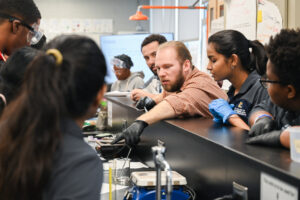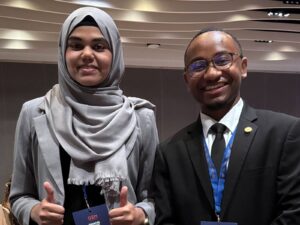NIST, UL Research Institutes Leaders Discuss Education and Workforce Initiatives as Part of CHIPS and Science Program

The National Institute of Standards and Technology (NIST) plans to increase investment in educational and workforce initiatives as it administers a $50 billion CHIPS for America Fund, said NIST Director Laurie Locascio, Ph.D., in an interview with Dr. Chris Cramer, UL Research Institutes’ chief research officer.
“NIST is starting to develop some educational initiatives, and we’re funding some universities,” said Locascio, adding, “We intend to increase that.”
Cramer interviewed Locascio for a virtual session at the UIDPVirtual 2022 conference, held Dec. 6–8. Much of the Dec. 6 discussion focused on the Creating Helpful Incentives to Produce Semiconductors and Science Act of 2022 (CHIPS and Science Act) — and the CHIPS for America Fund it created — as well as on the role standards development plays in the American economy. Enacted in August 2022, the CHIPS and Science Act invests nearly $250 billion in American semiconductor manufacturing and scientific research and development to advance multiple technological sectors.
NIST, part of the Commerce Department, has been charged with managing the $50 billion fund allocated to the initiative, Locascio said. NIST aims to use that funding to build an entire semiconductor ecosystem, with opportunities for workforce development throughout the investment program, she said.
Locascio emphasized that NIST seeks to partner with industry, government agencies, and higher education institutions to help the future workforce understand the value of standards and the process by which they are developed. NIST awarded a total of nearly $500,000 to five universities last fall to support standards education in undergraduate and graduate curricula, and aims to increase those kinds of awards for educational institutions, she said.
Both Locascio and Cramer called for greater general awareness of standards and standards development organizations, such as UL Standards & Engagement, another independent UL enterprise affiliate. Despite the impact standards have on the U.S. economy, many people not directly involved in the marketplace are unfamiliar with the role standards play, Cramer noted.
“In order for standards to be most effective, we need many stakeholders to be involved in their development,” Cramer said. “So what are the mechanisms that are most helpful to increase academic and industrial engagement with standards development organizations?”
Throughout the discussion, Locascio underscored that NIST officials consider partnerships critical to their implementation of the act. NIST will seek to engage a wide array of partners to help build a robust research and development program, she said.
“I hope everybody listening sees potential for their institutions to join the program, participate in this and all the other R&D investments to follow,” Locascio said.
PUBLISHED









